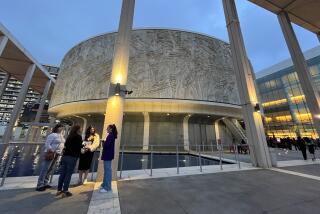Pasadena Playhouse will close Feb. 7
The Pasadena Playhouse will close Feb. 7 after the final performance of its current show, “Camelot,” as leaders of the 90-year-old landmark theater search for ways out of serious financial difficulties.
Among the options they are considering is a bankruptcy filing.
FOR THE RECORD:
‘Looped’: An article in Section A on Saturday about the upcoming closure of the Pasadena Playhouse referred to “Looped” as a one-woman play about actress Tallulah Bankhead. Michael Mulheren and Brian Hutchison also appear in the show. —
Executive director Stephen Eich said the playhouse is essentially out of cash and faces more than $500,000 in immediate bills, as well as payments on more than $1.5 million in bank loans and other debts that have dogged the nonprofit company since the mid-1990s. Thirty-seven employees learned at a staff meeting Thursday that they would be out of work.
Eich said that tapping into $6 million donated for a capital campaign to refurbish the playhouse was not an option. “It just would not be any way for us to solve the problems of the place,” he said.
Eich said that he, longtime artistic director Sheldon Epps and the playhouse’s board will instead try to develop a plan to set the company on its feet, rather than keep it going on the hand-to-mouth basis that became impossible in a down economy that took a toll on donations.
Founded in 1917, the playhouse was designated in 1937 as the state theater of California. Actors such as Dustin Hoffman and Gene Hackman have been associated with it through the years, and the current company has launched productions that went on to runs elsewhere: The musical adaptation of the hit film “Sister Act” is currently playing in London, and “Looped,” a one-woman show about Tallulah Bankhead starring Valerie Harper that was seen at the playhouse in 2008, is to open on Broadway this spring.
“What a loss it would be if the theater is not able to come back,” said Leslie Uggams, who opened as Lena Horne there a year ago in “Stormy Weather,” a musical biography of the jazz great that was the playhouse’s last box office hit. “It’s gorgeous, it’s historical. I just loved the theater, the people who worked there, and the audiences who came seemed so loyal. What a shame that would be.”
Teresa Eyring, executive director of the Theatre Communications Group, the nation’s leading service organization for nonprofit theaters, said Friday: “I think people will be startled by it, surprised and concerned, and will want to help. Sheldon has a fantastic reputation, and it’s one of the oldest theaters in the country.”
The playhouse’s first step, Eich said, will be hiring a lawyer to advise officials on such matters as a possible bankruptcy filing. Eich said he isn’t sure if the playhouse’s 8,000 subscribers will be reimbursed.
“We have subscribers wanting to see the rest of the season. We’re devastated by that,” he said.
Asked about the playhouse’s chances of surviving a shutdown, Eich said: “There is an unequivocal desire for the playhouse to survive. It seems to me that for that to occur, our position in the community needs to be redefined as it relates to the city and the funding community. Work needs to be done.”
The playhouse had pinned its hopes on finding someone who would give $5 million to have the 684-seat main stage named in his or her honor, Eich said, but that hasn’t materialized.
Epps said he hasn’t given up hope of a transforming donation. When the Museum of Contemporary Art in downtown Los Angeles was in a comparable situation, philanthropist Eli Broad stepped in with a $30-million pledge.
“Some irons have been in the fire and are now, but they take a lot of time and cultivation,” Epps said. “We know that despite the economy, those kinds of gifts are made to arts organizations.”
One question, Epps said, is whether the city of Pasadena will be willing to offer financial help. The city currently provides a $1-a-year sublease on the performance spaces of the larger, privately owned theater building.
The recession has already claimed one large arts organization in Southern California: In November 2008, Opera Pacific, based at the Orange County Performing Arts Center in Costa Mesa, filed for Chapter 7 bankruptcy and went out of existence.
The playhouse appears to be the second-largest nonprofit theater in the country to have halted operations amid the economic turbulence. North Shore Music Theatre in Beverly, Mass., went permanently belly up last summer under $10 million in debt.
Smaller companies in Milwaukee and Madison, Wis.; Stamford, Conn.; Akron, Ohio; and Orlando, Fla., have also succumbed, Eyring said.
The Pasadena Playhouse’s financial problems surfaced in late September, when it closed a show a week early to save on expenses: “The Night of the Child,” a drama by Charles Randolph-Wright that starred JoBeth Williams.
Eich said at the time that four employees had been laid off, and that the playhouse needed donations of more than $1 million by year’s end to cover up to $600,000 in bills and create a cushion as it headed into the 2010 season.
Before the downturn, the playhouse had visions of bigger things. In 2007 it announced that architect Frank Gehry was donating his services to design a new, 300- to 400-seat theater to augment the main stage, a 684-seat house in the Spanish Colonial Revival building that is a California historical landmark.
Before tackling that larger project, Gehry was going to redo the existing second stage, the 86-seat Carrie Hamilton Theatre. That space is named in memory of the actress daughter of playhouse board member Carol Burnett (Hamilton died of cancer in 2002), and has been home to the well-regarded Furious Theatre Company, whose leader, Damaso Rodriguez, is associate artistic director of the playhouse.
Epps said it is uncertain how the playhouse’s closing will affect the smaller company, which uses the Hamilton rent-free. A Furious Theatre spokesman said that the Feb. 20 opening of “Men of Tortuga” by Jason Wells is still scheduled, pending developments, but that the company will move if necessary.
Although the playhouse had announced fundraising successes in recent years, including a $3-million gift from an anonymous donor in October 2008, Epps said last fall that some of those were pledges to be paid over a long term.
The playhouse’s debt dates to before the present organization existed. The city bought the building in 1975 and later transferred it to real estate developer David Houk. He relaunched the theater in 1986 as a place to develop shows that would tour other California venues under the banner of Houk’s Theatre Corp. of America. The plan made some headway, but in 1994 it crumbled during a recessionary economy, and in 1995 Houk’s business went bankrupt.
The nonprofit corporation that now runs the theater had to shoulder about $2.5 million in leftover debt.
In 1997, Epps was hired from the Old Globe in San Diego, where he had been associate artistic director. Under Epps and executive director Lyla White, the playhouse chipped away at the debt that Epps wryly refers to as “alimony from a marriage that I was never in.” But the post-Sept. 11 recession led to a dwindling of donations and more red ink.
The playhouse rebounded, enjoying budget surpluses and scoring artistic and box-office successes with shows such as a 2006 production of August Wilson’s “Fences” with Laurence Fishburne and Angela Bassett. It grossed more than $1 million, fueling a peak financial year for the playhouse, which saw revenue rise to $9.2 million. But the flush times didn’t last: In 2008, records show, the playhouse’s box-office take fell from $4 million to $3.2 million, its lowest since 2003.
The mood at the Thursday meeting went “from sadness to anger and frustration but eventually to hope that putting the brakes on and digging in and doing the [financial] work is going to lead us to a better place,” Epps said.
More to Read
The biggest entertainment stories
Get our big stories about Hollywood, film, television, music, arts, culture and more right in your inbox as soon as they publish.
You may occasionally receive promotional content from the Los Angeles Times.







